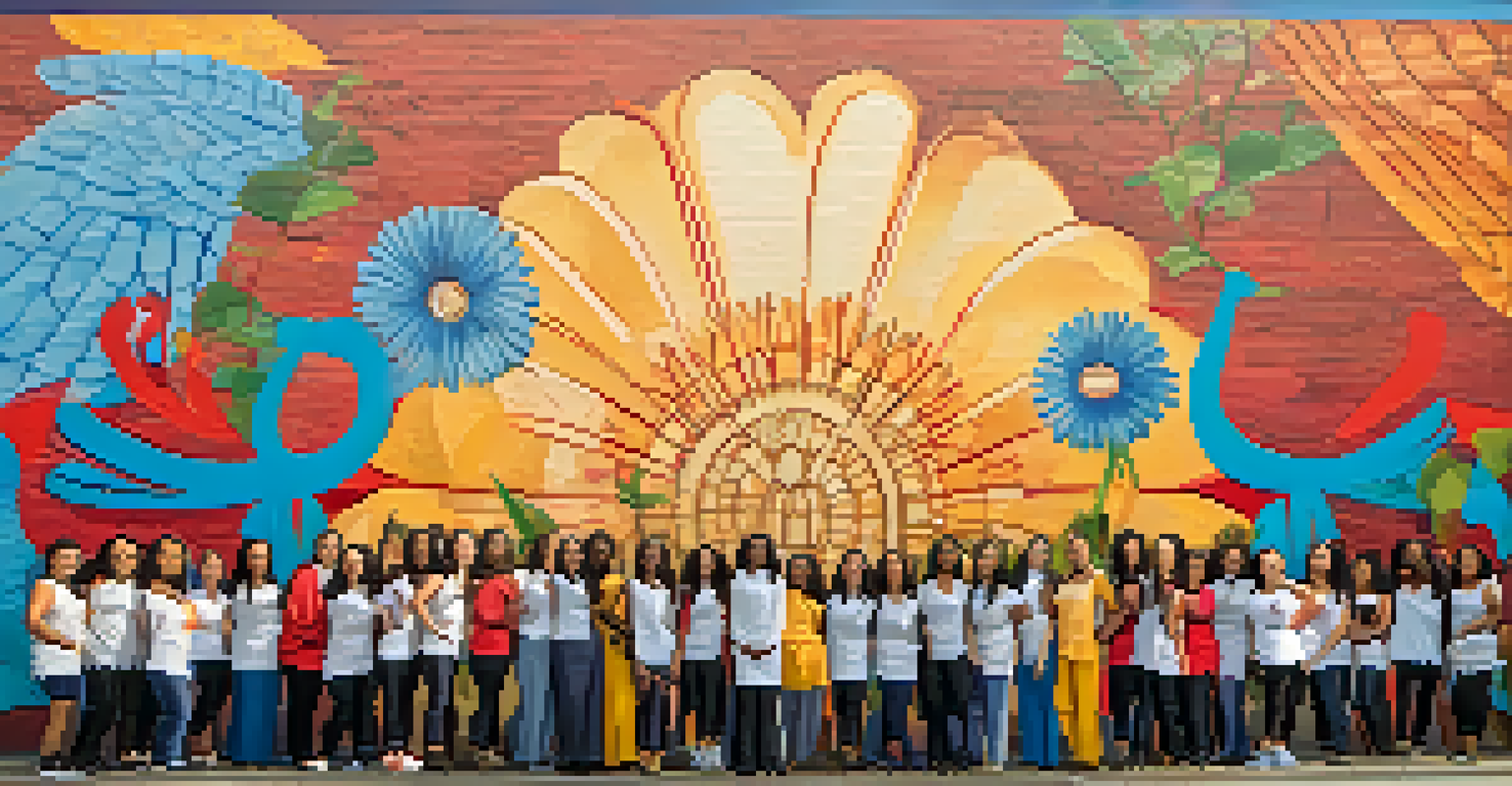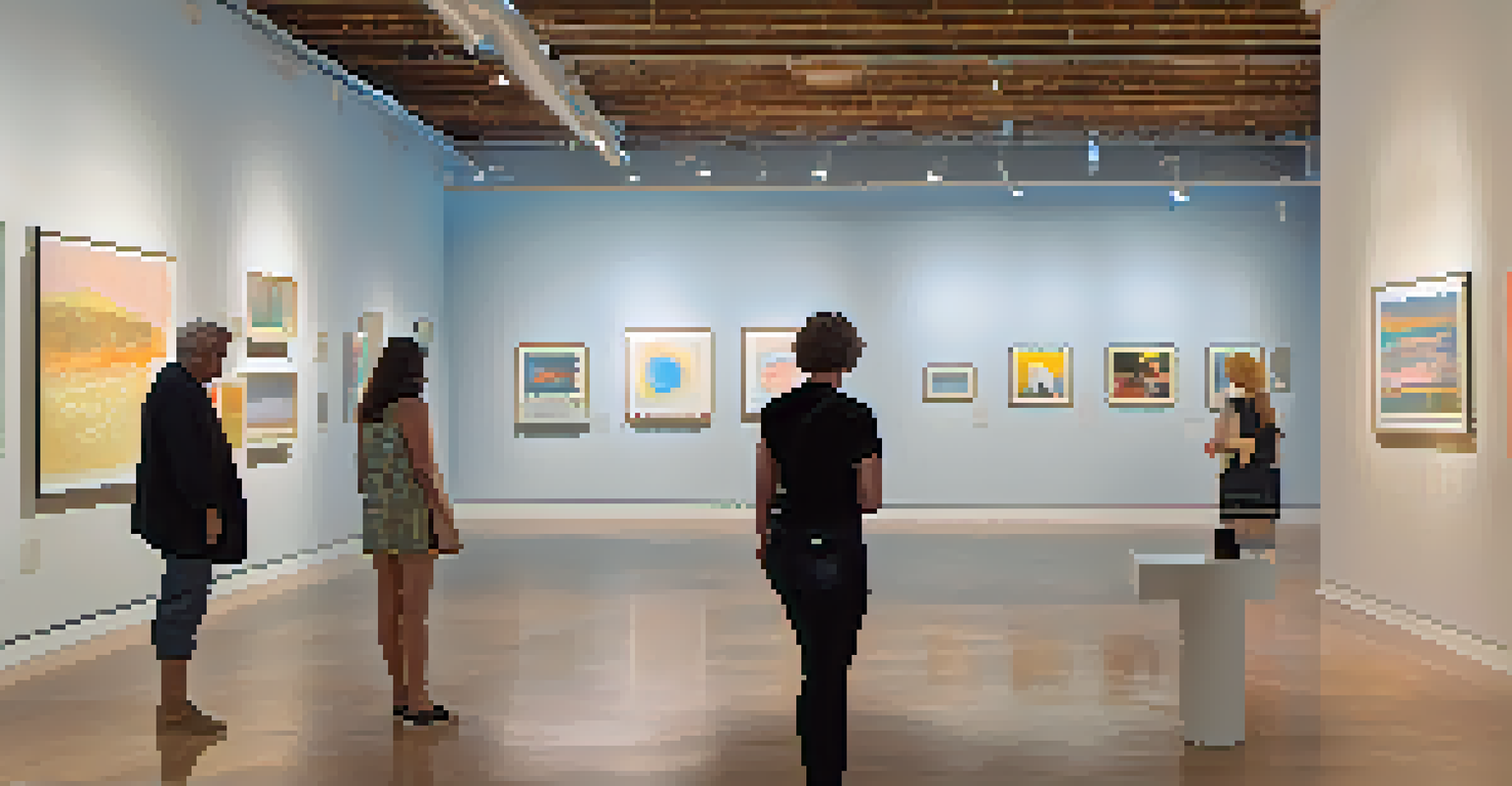Art and the Feminist Movement: A Historical Perspective

Defining Feminism and Its Impact on Art
Feminism, at its core, advocates for women's rights and equality. It has significantly influenced various fields, including art. Artists began to challenge traditional representations of women, pushing back against the male-dominated narratives in art history.
Feminism is the radical notion that women are human beings.
Throughout time, feminist movements have inspired artists to reflect on women's experiences and identities. This has led to a rich tapestry of artistic expression that not only highlights women's roles but also critiques societal norms. By doing so, artists have opened up conversations about gender, power, and representation.
Feminist art serves as a platform for marginalized voices, encouraging women to share their stories and perspectives. This shift in focus has empowered many artists to explore themes of gender and identity, ultimately enriching the art world with diverse viewpoints.
Early Feminist Artists and Their Contributions
In the 1960s and 1970s, a wave of feminist artists emerged, each making significant contributions to the movement. Artists like Judy Chicago and Miriam Schapiro utilized their work to highlight women's history and experiences. Chicago's 'The Dinner Party' is a seminal piece that celebrates women's achievements throughout history.

These early pioneers faced numerous challenges, often being dismissed or overlooked in a male-dominated art scene. Despite this, they forged ahead, using their art to create spaces for dialogue and change. Their bravery set the stage for future generations of female artists.
Feminism Transforms Art Narratives
Feminism has reshaped art by challenging traditional representations and amplifying women's voices.
Their impact is still felt today, inspiring contemporary artists to continue exploring feminist themes. By reclaiming narratives and celebrating female experiences, these artists have paved the way for a more inclusive art world.
The Role of Institutional Support in Feminist Art
Institutions like museums and galleries have played a crucial role in promoting feminist art. In the past, many institutions were hesitant to showcase women artists, but this has significantly changed over recent decades. Today, exhibitions dedicated to feminist artists are more common, providing visibility and recognition.
Art is a way of survival.
Art institutions have also begun to actively collect works by women artists, reflecting a broader commitment to diversity and inclusion. This change not only supports female artists but also enriches the cultural landscape by introducing audiences to varied perspectives. It’s a win-win situation.
Additionally, educational programs and workshops focusing on feminist art have emerged, further fostering awareness and appreciation. By supporting women's voices, these institutions help to challenge and dismantle the biases that have historically marginalized female artists.
Intersectionality: Expanding the Feminist Art Narrative
Intersectionality is a critical framework that examines how various social identities—such as race, class, and sexuality—intersect with gender. This concept has increasingly influenced feminist art, prompting artists to consider multiple dimensions of identity in their work. It has led to a richer and more nuanced understanding of women's experiences.
Artists from diverse backgrounds, such as Kerry James Marshall and Frida Kahlo, have utilized their art to explore intersectional themes. Their works challenge monolithic representations of womanhood and highlight the complexities of identity. This approach not only broadens the feminist art narrative but also fosters inclusivity.
Intersectionality Enriches Art
The concept of intersectionality has expanded the feminist art narrative by highlighting the complexities of identity.
By embracing intersectionality, feminist art can resonate with a wider audience, inviting dialogue across different communities. This evolution in the narrative underscores the importance of acknowledging and celebrating diverse voices within the feminist movement.
Contemporary Feminist Art and Activism
Today, contemporary feminist art often intersects with activism, using creativity as a tool for social change. Artists engage with pressing issues like gender-based violence, reproductive rights, and body positivity. This blend of art and activism amplifies the feminist message and encourages collective action.
Works by artists such as Ai Weiwei and the Guerrilla Girls challenge societal norms and provoke thought. Through various mediums, they address issues of inequality and injustice, making their art not just visually compelling but also socially relevant. Their work inspires others to reflect on and engage with feminist issues.
Furthermore, social media has become a powerful platform for contemporary feminist artists to share their work and connect with audiences. By leveraging technology, artists can reach a global audience and foster community engagement, ensuring that feminist art continues to thrive in modern society.
The Future of Feminist Art
As we look to the future, the evolution of feminist art appears promising. New generations of artists are emerging, ready to challenge existing narratives and explore fresh perspectives. With the support of institutions and the power of technology, the feminist art movement is poised to grow even further.
The ongoing conversations about gender equality and representation in society will undoubtedly influence the themes explored in future feminist art. Artists will likely continue to examine intersectionality and the complexities of identity, pushing boundaries and expanding the narrative.
Art as a Tool for Activism
Contemporary feminist art increasingly merges with activism, addressing critical social issues and fostering community engagement.
Ultimately, the future of feminist art lies in its ability to adapt and respond to societal changes. By remaining relevant and inclusive, feminist art will continue to inspire and engage audiences, ensuring its enduring impact on culture and society.
Conclusion: The Lasting Legacy of Feminist Art
The feminist art movement has made significant strides in reshaping the art world and challenging societal norms. By advocating for women's rights and diverse representations, feminist artists have created a lasting legacy that continues to inspire. Their work has not only enriched the art landscape but also fostered important conversations about gender and identity.
As we reflect on the historical perspective of art and feminism, it’s essential to recognize the contributions of both past and present artists. Their dedication to amplifying women's voices has paved the way for future generations to explore and express their own stories.

In conclusion, the intersection of art and the feminist movement serves as a powerful reminder of the role that creativity plays in advocating for social change. As the movement progresses, it will continue to challenge perceptions and inspire new forms of expression, ensuring that the legacy of feminist art endures.